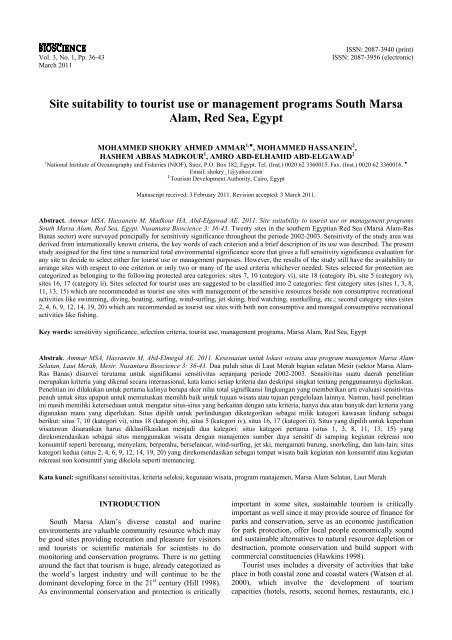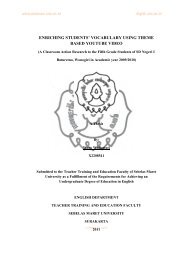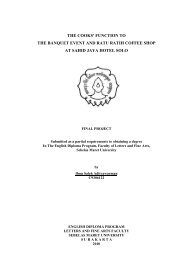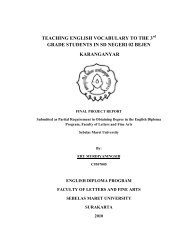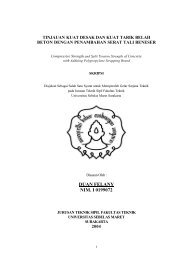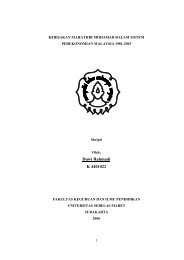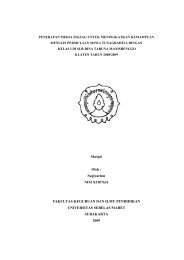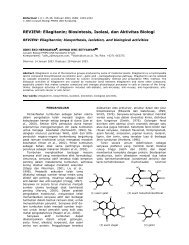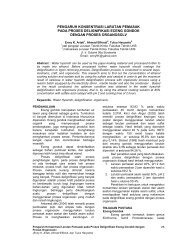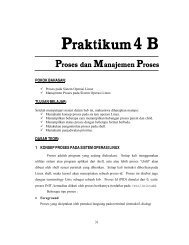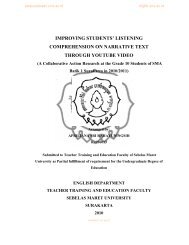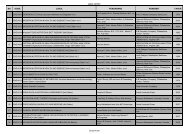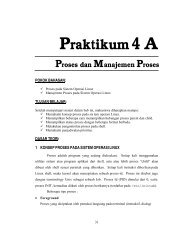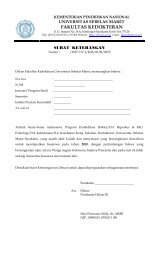ISSN 2087-3940 (PRINT) | ISSN 2087-3956 ... - Biodiversitas
ISSN 2087-3940 (PRINT) | ISSN 2087-3956 ... - Biodiversitas
ISSN 2087-3940 (PRINT) | ISSN 2087-3956 ... - Biodiversitas
Create successful ePaper yourself
Turn your PDF publications into a flip-book with our unique Google optimized e-Paper software.
Vol. 3, No. 1, Pp. 36-43<br />
March 2011<br />
<strong>ISSN</strong>: <strong>2087</strong>-<strong>3940</strong> (print)<br />
<strong>ISSN</strong>: <strong>2087</strong>-<strong>3956</strong> (electronic)<br />
Site suitability to tourist use or management programs South Marsa<br />
Alam, Red Sea, Egypt<br />
MOHAMMED SHOKRY AHMED AMMAR 1,♥ , MOHAMMED HASSANEIN 2 ,<br />
HASHEM ABBAS MADKOUR 1 , AMRO ABD-ELHAMID ABD-ELGAWAD 2<br />
1 National Institute of Oceanography and Fisheries (NIOF), Suez, P.O. Box 182, Egypt. Tel. (Inst.) 0020 62 3360015. Fax. (Inst.) 0020 62 3360016. ♥<br />
Email: shokry_1@yahoo.com<br />
2<br />
Tourism Development Authority, Cairo, Egypt<br />
Manuscript received: 3 February 2011. Revision accepted: 3 March 2011.<br />
Abstract. Ammar MSA, Hassanein M, Madkour HA, Abd-Elgawad AE. 2011. Site suitability to tourist use or management programs<br />
South Marsa Alam, Red Sea, Egypt. Nusantara Bioscience 3: 36-43. Twenty sites in the southern Egyptian Red Sea (Marsa Alam-Ras<br />
Banas sector) were surveyed principally for sensitivity significance throughout the periode 2002-2003. Sensitivity of the study area was<br />
derived from internationally known criteria, the key words of each criterion and a brief description of its use was described. The present<br />
study assigned for the first time a numerical total environmental significance score that gives a full sensitivity significance evaluation for<br />
any site to decide to select either for tourist use or management purposes. However, the results of the study still have the availability to<br />
arrange sites with respect to one criterion or only two or many of the used criteria whichever needed. Sites selected for protection are<br />
categorized as belonging to the following protected area categories: sites 7, 10 (category vi), site 18 (category ib), site 5 (category iv),<br />
sites 16, 17 (category ii). Sites selected for tourist uses are suggested to be classified into 2 categories: first category sites (sites 1, 3, 8,<br />
11, 13, 15) which are recommended as tourist use sites with management of the sensitive resources beside non consumptive recreational<br />
activities like swimming, diving, boating, surfing, wind-surfing, jet skiing, bird watching, snorkelling, etc.; second category sites (sites<br />
2, 4, 6, 9, 12, 14, 19, 20) which are recommended as tourist use sites with both non consumptive and managed consumptive recreational<br />
activities like fishing.<br />
Key words: sensitivity significance, selection criteria, tourist use, management programs, Marsa Alam, Red Sea, Egypt<br />
Abstrak. Ammar MSA, Hassanein M, Abd-Elmegid AE. 2011. Kesesuaian untuk lokasi wisata atau program manajemen Marsa Alam<br />
Selatan, Laut Merah, Mesir. Nusantara Bioscience 3: 36-43. Dua puluh situs di Laut Merah bagian selatan Mesir (sektor Marsa Alam-<br />
Ras Banas) disurvei terutama untuk signifikansi sensitivitas sepanjang periode 2002-2003. Sensitivitas suatu daerah penelitian<br />
merupakan kriteria yang dikenal secara internasional, kata kunci setiap kriteria dan deskripsi singkat tentang penggunaannya dijelaskan.<br />
Penelitian ini dilakukan untuk pertama kalinya berupa skor nilai total signifikansi lingkungan yang memberikan arti evaluasi sensitivitas<br />
penuh untuk situs apapun untuk memutuskan memilih baik untuk tujuan wisata atau tujuan pengelolaan lainnya. Namun, hasil penelitian<br />
ini masih memiliki ketersediaan untuk mengatur situs-situs yang berkaitan dengan satu kriteria, hanya dua atau banyak dari kriteria yang<br />
digunakan mana yang diperlukan. Situs dipilih untuk perlindungan dikategorikan sebagai milik kategori kawasan lindung sebagai<br />
berikut: situs 7, 10 (kategori vi), situs 18 (kategori ib), situs 5 (kategori iv), situs 16, 17 (kategori ii). Situs yang dipilih untuk keperluan<br />
wisatawan disarankan harus diklasifikasikan menjadi dua kategori: situs kategori pertama (situs 1, 3, 8, 11, 13, 15) yang<br />
direkomendasikan sebagai situs menggunakan wisata dengan manajemen sumber daya sensitif di samping kegiatan rekreasi non<br />
konsumtif seperti berenang, menyelam, berperahu, berselancar, wind-surfing, jet ski, mengamati burung, snorkeling, dan lain-lain; situs<br />
kategori kedua (situs 2, 4, 6, 9, 12, 14, 19, 20) yang direkomendasikan sebagai tempat wisata baik kegiatan non konsumtif atau kegiatan<br />
rekreasi non konsumtif yang dikelola seperti memancing.<br />
Kata kunci: signifikansi sensitivitas, kriteria seleksi, kegunaan wisata, program manajemen, Marsa Alam Selatan, Laut Merah<br />
INTRODUCTION<br />
South Marsa Alam’s diverse coastal and marine<br />
environments are valuable community resource which may<br />
be good sites providing recreation and pleasure for visitors<br />
and tourists or scientific materials for scientists to do<br />
monitoring and conservation programs. There is no getting<br />
around the fact that tourism is huge, already categorized as<br />
the world’s largest industry and will continue to be the<br />
dominant developing force in the 21 st century (Hill 1998).<br />
As environmental conservation and protection is critically<br />
important in some sites, sustainable tourism is critically<br />
important as well since it may provide source of finance for<br />
parks and conservation, serve as an economic justification<br />
for park protection, offer local people economically sound<br />
and sustainable alternatives to natural resource depletion or<br />
destruction, promote conservation and build support with<br />
commercial constituencies (Hawkins 1998).<br />
Tourist uses includes a diversity of activities that take<br />
place in both coastal zone and coastal waters (Watson et al.<br />
2000), which involve the development of tourism<br />
capacities (hotels, resorts, second homes, restaurants, etc.)


